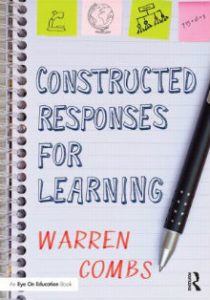The Power of Constructed Responses for Learning
Constructed Responses for Learning
By Warren Combs
(Routledge/Eye On Education, 2016 – Learn more)
Warren Combs’ new book successfully demonstrates the power of constructed responses as a teaching tool, not just an assessment tool (as it tends to be utilized in schools). His 13-chapter work is jam-packed with powerful strategies that any teacher could use in grades K-12 and beyond.
I came upon Constructed Responses for Learning when I was looking for a professional text to use with teachers for a book study. I needed a book with strategies that could help students respond to literature, without it becoming “test prepping.”

As a literacy consultant working with teachers, I stress the importance of teachers planning lessons that focus on students using critical thinking and reasoning skills. This would ensure that students learn content deeply instead of just memorizing and regurgitating information.
As Combs points out, learning in schools should be more than just preparing students to do well on assessments, especially since state standards and assessments expect more than just the memorization of information. For today’s world and assessments, students have to be able to apply skills in order to demonstrate they have mastered content.
A book that can help us move beyond fear
Although many educators may agree about not doing the many hours of “test prepping,” the pressure and fear of students’ not meeting state standards often perpetuates the misguided need for schools to focus on numerous “test prepping activities.”
Luckily for us, Warren Combs’ new book appears just in time to help teachers and administrators recognize the value and strength of using constructed responses throughout the school year for learning and instruction.
I believe Combs’ book could be a true treasure for all educators K-12+. It may be especially useful for literacy coaches and instructional leaders. I see this book being easily utilized in professional learning communities (PLCs), grade level/team meetings, staff meetings, book clubs, etc.
Combs’ book is divided into three sections with the most valuable parts in chapters 4 through 11.
Section 1: The Rush to Constructed Responses
Chapter 1: “Constructed Responses for Assessment and Learning: K-12 Preparation for College and Career” starts with a brief history of the use of constructed responses in this country for assessing teachers and students. It then goes on to discuss the value of using constructed responses for much more: learning!
Combs makes two points clear. First, constructed responses need not be limited to reading and responding to texts. He makes the argument that students can construct responses to “learning experiences in labs, media centers, classroom lectures, demonstrations, discussions, learning centers, oral presentations, PALS partners, small groups, video presentations, and self-guided research” (p. 11). Second, he states that constructed responses may be oral.
Chapter 2: “The Five Key Practices of Constructed Responses for Learning” details steps that Combs wants us to take each time we prompt students for a constructed response. He strongly believes that these practices will ensure that students are able to fully explain what they know. A mnemonic to keep the Five Key Practices in mind when prompting students to write is QM-GPS. “It’s my Quiet Motion Global Positioning System.” (p. 22).
Five Key Practices:
- Quantify Teacher Expectations,
- Model Teacher Writing,
- Guide Student Choices, and
- Prompt PALS Responses, through
- Secured Student Self-Assessment.
Chapter 3: “An Interactive Log of Constructed Responses” is all about the classroom setting. As we all know, the classroom environment is critical to the proper implementation of best practices and learning. In this chapter, Combs provides examples, charts, rubrics and pictures that describe the essential conditions needed to support using constructed responses as a teaching tool.
Section 2: Critical-Thinking Strategies
Now for the heart of the book! Chapters 4 through 11 discuss several critical-thinking strategies and, in my opinion, are the strength of the book. Although many of you might already be familiar with most of these strategies, the way in which Combs describes their use will leave you thinking, “Wow!”
Each of the following chapters in this section describes various instructional strategies and how they may be used with emergent and independent writers. Additionally, Combs offers grade level exemplars of teacher and student writing and also shares testimonials from teachers and students about their experiences with these strategies. To stress the importance of always using the Five Key Practices, Combs makes sure to demonstrate how to apply the strategies with these practices.
Chapter 4: “Something on the Page That Helps You Remember What You Were Thinking (Letters, Words, Phrases, Numbers, Symbols, or Drawings)”
- The “Remember Game,” a strategy that helps students develop independence in their writing.
- The “Acrostic Vocabulary,” a strategy that develops students inductive thinking.
Chapter 5: “Free Writing Rigorous Thought”
- “Sentence Stems” and “Focused Free Writing” – two strategies that foster students to develop rigor in their writing.
Chapter 6: “Recalling Knowledge as Chunks in Writing”
- “Framed Stories” and “Copy and Continue” – two strategies that develop students’ inferencing skills.
Chapter 7: “Sharpening Understanding of Closely Related Words (Phrases, Numbers, Symbols, or Formulas)”
- “Quad Clusters” – a strategy that cultivates critical thinking. (My favorite strategy!)
Chapter 8: “Arriving in a World of Analogies (Words, Equations, Phrases, Ideas, Events, Numbers, Symbols, or Formulas)”
- “Analogy” – another strategy for developing critical thinking.
Chapter 9: “From General to Specific (Telling to Showing)”
- “Slotting” – although a strategy for promoting strategic thought, Combs believes that it may be more suited for supporting revision.
Chapter 10: “Analyzing for Meaning”
- “Story Reporting” and “What I Thought You Taught” – two more strategies to promote inferencing.
Chapter 11: “Prepping for Argument”
- “Either… Or” – one more critical thinking strategy.
Section 3: An Ultimate Learning Routine
Chapter 12: “Putting It All Together” sums up the previous chapters and illustrates more examples of the strategies in use via modules.
Chapter 13: “Launching a Parting Shot” closes out the book with some final thoughts from the author. In this chapter, Combs shares his own observations about teachers who have successfully implemented constructed responses for learning in their classrooms.
This book is worth the read!
The author provides much support via exemplars and step-by-step suggestions on how to introduce these strategies for both emergent and independent writers. Although this book is slated for K-12 educators, I truly believe that higher education professors could easily utilize the strategies to get their students to think more critically about content.
This book effortlessly demonstrates the power of using short, frequent writing to learn activities that focus on standards across the curriculum.
Laurell Parris (laurellparris@gmail.com) is an literacy consultant and coach who provides standards-based, job-embedded professional development to districts and schools. Laurell started her career as a first grade teacher. She was a literacy coach, language arts supervisor and building level administrator. Additionally, Laurell has been an adjunct instructor at Rider University and is the co-director of the National Writing Project@Rider. Laurell lives in eastern Pennsylvania and enjoys working with teachers and students in the classroom.


































